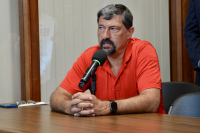The media is the muse: Jackson County potter will set up studios at Green Energy Park
By Sarah Kucharski • Staff Writer
From behind the waist-high counter that divides his studio and gallery in half, potter Mark Karner pauses for a moment to extend a hand and make introductions before getting back to work applying handles to four planters just beginning to dry.
He works with a precise quickness characteristic of an artist with a process. He cuts off the ends of pre-shaped bars of heavy, gray clay, scoring the area where the handle and planter will meet, and using either spit or a splash from the large bowl of water next to his throwing wheel, wets what will be the joint between the two. He presses the handle’s ends against the planter’s surface in a scalloped pattern using three thumbprints, and starts over on the next planter in line.
He talks, almost non-stop. The conversation — if you can call it that — is casual, affable, yet moves forward with purpose. It is this sort of diligence, and Karner’s experience building a pottery studio and gallery from scratch, that has earned him the responsibility of setting up potter’s studios at the Jackson County Green Energy Park.
“My goal is to set up an efficient workspace that will entice an aspiring professional to create,” Karner said.
The Park, located atop the county’s defunct landfill on the outskirts of Dillsboro, is being designed to operate using methane gas recovered from the decomposing trash buried below the surface.
Related Items
The gas recovery project is modeled after the EnergyXchange Renewable Energy Center at the Mitchell-Yancey landfill, the first glass blowing and pottery-making operation in the world fueled by landfill gas. The concept for the Mitchell-Yancey center was conceived by the community as a way to use the methane generated by the 300,000 tons of trash decomposing in its old landfill.
In comparison, Jackson County’s landfill holds nearly 420,000 tons of trash. It is estimated that the methane will produce a gas flow rate of 126 cubic feet per minute, or 2.9 million kilowatt hours of energy per year until 2028. The gas will be used to power blacksmithing forges and pottery kilns, as well as heat greenhouses.
Karner’s charge is to fit six studio spaces and a shared workspace for large scale tools such as a slab roller, a water source, and a glazing booth into an a approximately 2,000 square foot space. So far a lot of his work is research based, as he is looking at models like the EnergyXchange to get ideas.
“More than what’s working, what isn’t working — that’s what I want to know,” Karner said.
The studios will be used as business incubators of sorts, low rent units for potters fresh out of school who are looking to jump start their careers. The Green Energy Park — which is scheduled to open this October —will be billed as a working environmental- and arts-based attraction, drawing visitors who may come for the education and leave with a piece of pottery as a souvenir. Additionally, the artists’ studio space will feature a teaching studio for classes open to the public — another draw for potential customers.
“It’s exactly what any aspiring potter would want,” Karner said.
Mixing the environment and art comes naturally to Karner. Afraid to become an art major because he couldn’t draw well, Karner, a Port Huron, Mich., native, went to college to major in environmental studies.
However, his high school art classes didn’t include pottery and all it took was one course as a non-art major student to change his mind. In 1991 he quit school and transferred to a college in Durango, Colo., to become a professional potter.
After graduating, he took an internship in Swannee, Tenn., near the South Cumberland State Park. The internship afforded him experience, but little else. He soon opened his own gallery, the Fiery Gizzard.
It’s an odd, but memorable name taken from the Fiery Gizzard Trail that runs through the Grundy State Forest in Tennessee. And, “the metaphor works,” Karner said — an organ filled with stones versus the stoneware he creates.
However, the original home of the Fiery Gizzard was not rocky enough for Karner and seven years ago he began looking east in search of bigger mountains. His girlfriend, Anne, was in school at Western Carolina University earning a second degree in nursing. One day while visiting Karner stumbled into a real estate agent’s office. He explained what kind of set up he was looking for — a house with enough room to set up a studio and gallery where he could sell his wares, in a location that would attract commercial traffic. The agent said she knew just the place.
The house was located off U.S. 23-74 between Waynesville and Sylva. Karner called his girlfriend, and to seal the deal proposed.
“It was no huge surprise, but it was quite an extraordinary day,” Karner said.
The couple lived in the house for two and a half years before moving their residence a little further up Balsam Mountain. Karner rents the original house to his brother-in-law, but has kept his studio and gallery, which features his and his brother’s work. His brother, also a potter, is based in Durango, Co.
Karner works on a three-week cycle, throwing and firing pots. His pieces are largely influenced by nature, but their patterns and colors are abstract reflections.
“I try to get a certain amount of quiet elegance,” Karner said.
He specializes in three glazes including a deep glossy blue, speckled rust and copper red, which turn his functional pieces — teapots, tumblers and casserole dishes — into works of art. The colors are representative of the elements water, earth and fire, which are used to create pottery.
“In that sense I guess they’re the muse as well as the material,” Karner said.









